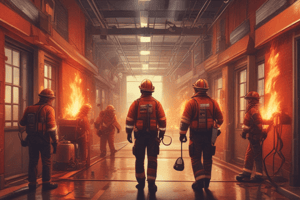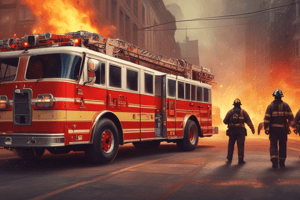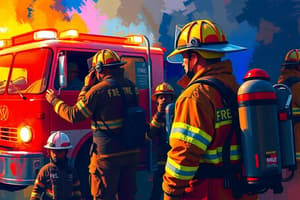Podcast
Questions and Answers
What was the primary purpose of the benchmark survey conducted?
What was the primary purpose of the benchmark survey conducted?
- To determine the current state of knowledge and practices. (correct)
- To assess the physical equipment of fire investigators.
- To evaluate the training needs of fire investigation agencies.
- To establish new regulations for fire scene operations.
Which organization is mentioned as a reference for standards regarding personal protective equipment?
Which organization is mentioned as a reference for standards regarding personal protective equipment?
- European Committee for Standardization (CEN)
- Occupational Safety and Health Administration (OSHA) (correct)
- International Fire Safety Association (IFSA)
- National Fire Protection Association (NFPA)
Which edition represented almost two years of work by the IAAI Health & Safety Committee?
Which edition represented almost two years of work by the IAAI Health & Safety Committee?
- Third edition (2022)
- First edition (2018) (correct)
- Second edition (2020)
- Fourth edition (2023)
What does the term 'best practice' refer to in the context of this document?
What does the term 'best practice' refer to in the context of this document?
Why can it be challenging for governments regarding health and safety standards?
Why can it be challenging for governments regarding health and safety standards?
The second edition (2020) included information on what aspect of fire investigator safety?
The second edition (2020) included information on what aspect of fire investigator safety?
Which of the following is NOT a focus of the best practices paper mentioned?
Which of the following is NOT a focus of the best practices paper mentioned?
How should readers approach the OSHA standards mentioned?
How should readers approach the OSHA standards mentioned?
What was a significant change regarding the approach to fire investigator health and safety since the original white paper was published?
What was a significant change regarding the approach to fire investigator health and safety since the original white paper was published?
Which of the following phrases best reflects the advancements in fire investigator health understanding?
Which of the following phrases best reflects the advancements in fire investigator health understanding?
What underlying issue does the IAAI Health & Safety Committee aim to address through their best practices paper?
What underlying issue does the IAAI Health & Safety Committee aim to address through their best practices paper?
What significant experience did David Rivers mention that highlights the importance of PPE and decontamination?
What significant experience did David Rivers mention that highlights the importance of PPE and decontamination?
How has the perception of data's role changed within the context of fire investigation since the early days?
How has the perception of data's role changed within the context of fire investigation since the early days?
What was one of the initial goals of the IAAI's best practices document?
What was one of the initial goals of the IAAI's best practices document?
Which aspect of fire investigation safety does the updated document emphasize based on the evolution of the field?
Which aspect of fire investigation safety does the updated document emphasize based on the evolution of the field?
What does Neil deGrasse Tyson's quote imply about the relationship between data and scientific maturity in fire investigation?
What does Neil deGrasse Tyson's quote imply about the relationship between data and scientific maturity in fire investigation?
What is the main health risk identified for firefighters after a live-fire training exercise?
What is the main health risk identified for firefighters after a live-fire training exercise?
What was the percentage of recorded exposures among fire investigators in North Carolina related to airborne PAHs?
What was the percentage of recorded exposures among fire investigators in North Carolina related to airborne PAHs?
What type of PAHs are produced in smoldering fires according to the findings?
What type of PAHs are produced in smoldering fires according to the findings?
What was the average exposure duration post-suppression for firefighters, as indicated in the findings?
What was the average exposure duration post-suppression for firefighters, as indicated in the findings?
Which hazardous gas levels were noted to increase over time after fire suppression?
Which hazardous gas levels were noted to increase over time after fire suppression?
What role did the IAAI Health & Safety Committee play in firefighter safety studies?
What role did the IAAI Health & Safety Committee play in firefighter safety studies?
How long did particulate levels remain hazardous at fire scenes?
How long did particulate levels remain hazardous at fire scenes?
What was the recommendation for public fire investigation units regarding SCBA usage?
What was the recommendation for public fire investigation units regarding SCBA usage?
Which of the following products is NOT mentioned as a source of harmful chemicals during a fire?
Which of the following products is NOT mentioned as a source of harmful chemicals during a fire?
What is a significant difference between inhalation exposure and dermal exposure as mentioned?
What is a significant difference between inhalation exposure and dermal exposure as mentioned?
What compounds are known to be emitted during incomplete combustion of materials in a fire?
What compounds are known to be emitted during incomplete combustion of materials in a fire?
Why is determining dermal occupational exposure limits particularly challenging?
Why is determining dermal occupational exposure limits particularly challenging?
What is a recommended method to limit chemical absorption through the skin after a fire?
What is a recommended method to limit chemical absorption through the skin after a fire?
What role does the World Health Organization play in regards to dermal exposure limits?
What role does the World Health Organization play in regards to dermal exposure limits?
Which statement regarding the permeability of materials during fires is accurate?
Which statement regarding the permeability of materials during fires is accurate?
Which item is categorized as a known carcinogen when burned?
Which item is categorized as a known carcinogen when burned?
What is the recommended amount of sleep for individual fire investigators to manage health risk factors?
What is the recommended amount of sleep for individual fire investigators to manage health risk factors?
Which of the following practices is NOT advised for maintaining health as an individual fire investigator?
Which of the following practices is NOT advised for maintaining health as an individual fire investigator?
What type of clothing is recommended for fire investigators to wear?
What type of clothing is recommended for fire investigators to wear?
Why is it important for fire investigators to be fit-tested on assigned respirators?
Why is it important for fire investigators to be fit-tested on assigned respirators?
What should fire investigators do to prepare for adverse weather conditions while en route to an incident?
What should fire investigators do to prepare for adverse weather conditions while en route to an incident?
What health check is specifically recommended for fire investigators due to increased skin cancer risk?
What health check is specifically recommended for fire investigators due to increased skin cancer risk?
Why should fire investigators avoid having facial hair?
Why should fire investigators avoid having facial hair?
What is the primary reason fire investigators should have knowledge of emergency medical facilities near incident scenes?
What is the primary reason fire investigators should have knowledge of emergency medical facilities near incident scenes?
What is a primary hazard associated with lithium-ion battery fires?
What is a primary hazard associated with lithium-ion battery fires?
What type of foam is typically used to extinguish fires caused by wood and paper?
What type of foam is typically used to extinguish fires caused by wood and paper?
Which of the following is a potential special hazard when working with certain refrigerants?
Which of the following is a potential special hazard when working with certain refrigerants?
What is the critical precaution when firefighters suspect the presence of PFAS at a scene?
What is the critical precaution when firefighters suspect the presence of PFAS at a scene?
What distinguishes fluorinated foams from fluorine-free foams?
What distinguishes fluorinated foams from fluorine-free foams?
What should be implemented to reduce scene hazards in firefighting?
What should be implemented to reduce scene hazards in firefighting?
What is the primary reason firefighting personnel might require Self-Contained Breathing Apparatus (SCBA) during operations?
What is the primary reason firefighting personnel might require Self-Contained Breathing Apparatus (SCBA) during operations?
When referring to shock hazards, what is the minimum voltage defined as a shock hazard?
When referring to shock hazards, what is the minimum voltage defined as a shock hazard?
Flashcards
Post-fire Environment Hazards
Post-fire Environment Hazards
The potential health hazards present in the post-fire environment.
Personal Protective Equipment (PPE)
Personal Protective Equipment (PPE)
Specialized clothing and equipment designed to protect individuals from hazards in the post-fire environment.
Decontamination
Decontamination
The process of removing or minimizing contamination from a person or object.
Fire Investigator Health and Safety Best Practices
Fire Investigator Health and Safety Best Practices
Signup and view all the flashcards
Scientific Approach to Fire Investigations
Scientific Approach to Fire Investigations
Signup and view all the flashcards
Evidence-Based Fire Investigation
Evidence-Based Fire Investigation
Signup and view all the flashcards
Data-Driven Fire Investigation
Data-Driven Fire Investigation
Signup and view all the flashcards
Comprehensive Fire Investigation
Comprehensive Fire Investigation
Signup and view all the flashcards
Benchmark Survey
Benchmark Survey
Signup and view all the flashcards
Best Practices
Best Practices
Signup and view all the flashcards
Government Standards and Regulations
Government Standards and Regulations
Signup and view all the flashcards
Historical Research Data
Historical Research Data
Signup and view all the flashcards
Health and Safety Standards
Health and Safety Standards
Signup and view all the flashcards
Best Practice Approach
Best Practice Approach
Signup and view all the flashcards
Best Practices Paper
Best Practices Paper
Signup and view all the flashcards
Continually Evolving Subject
Continually Evolving Subject
Signup and view all the flashcards
What contaminants are released during live-fire training?
What contaminants are released during live-fire training?
Signup and view all the flashcards
What is the aim of the service training facility study?
What is the aim of the service training facility study?
Signup and view all the flashcards
What was the main source of PAH exposure for North Carolina fire investigators?
What was the main source of PAH exposure for North Carolina fire investigators?
Signup and view all the flashcards
What were the key findings of the University of Miami wristband study?
What were the key findings of the University of Miami wristband study?
Signup and view all the flashcards
How do gas levels change in the post-fire environment?
How do gas levels change in the post-fire environment?
Signup and view all the flashcards
What is the emerging trend in post-fire scene examination?
What is the emerging trend in post-fire scene examination?
Signup and view all the flashcards
How does planning impact post-fire scene examination time?
How does planning impact post-fire scene examination time?
Signup and view all the flashcards
What was the role of the IAAI Health & Safety Committee?
What was the role of the IAAI Health & Safety Committee?
Signup and view all the flashcards
Planning for travel
Planning for travel
Signup and view all the flashcards
Weather awareness
Weather awareness
Signup and view all the flashcards
Understanding the scene
Understanding the scene
Signup and view all the flashcards
Emergency medical plan
Emergency medical plan
Signup and view all the flashcards
Weather-appropriate clothing
Weather-appropriate clothing
Signup and view all the flashcards
Healthy lifestyle
Healthy lifestyle
Signup and view all the flashcards
Physical fitness
Physical fitness
Signup and view all the flashcards
Annual health checks
Annual health checks
Signup and view all the flashcards
What are some common sources of hazardous chemicals in a post-fire environment?
What are some common sources of hazardous chemicals in a post-fire environment?
Signup and view all the flashcards
What are the dangers of burning common household products?
What are the dangers of burning common household products?
Signup and view all the flashcards
What are PAHs and why are they a concern in post-fire environments?
What are PAHs and why are they a concern in post-fire environments?
Signup and view all the flashcards
Why is dermal exposure a concern in post-fire environments?
Why is dermal exposure a concern in post-fire environments?
Signup and view all the flashcards
How can we limit dermal exposure in post-fire environments?
How can we limit dermal exposure in post-fire environments?
Signup and view all the flashcards
How does temperature affect the absorption of chemicals through the skin?
How does temperature affect the absorption of chemicals through the skin?
Signup and view all the flashcards
Is the claim about skin permeability increasing with temperature accurate?
Is the claim about skin permeability increasing with temperature accurate?
Signup and view all the flashcards
What steps should be taken to reduce exposure to chemicals in post-fire environments?
What steps should be taken to reduce exposure to chemicals in post-fire environments?
Signup and view all the flashcards
PFAS in Firefighting Foam
PFAS in Firefighting Foam
Signup and view all the flashcards
Lithium-ion Battery Fire Hazards
Lithium-ion Battery Fire Hazards
Signup and view all the flashcards
Refrigerant Fire Hazards
Refrigerant Fire Hazards
Signup and view all the flashcards
Engineering Controls
Engineering Controls
Signup and view all the flashcards
Special Precautions for Hazardous Materials
Special Precautions for Hazardous Materials
Signup and view all the flashcards
Hazard Elimination
Hazard Elimination
Signup and view all the flashcards
Specialized Resources
Specialized Resources
Signup and view all the flashcards
IDLH (Immediately Dangerous to Life or Health)
IDLH (Immediately Dangerous to Life or Health)
Signup and view all the flashcards
Study Notes
Fire Investigator Health and Safety Best Practices
- This third edition of Fire Investigator Health and Safety Best Practices was prepared by the Health & Safety Committee of the International Association of Arson Investigators, Inc. (IAAI)
- It includes an advisory panel of subject matter experts, and other technical advisors and has been approved by the IAAI Training & Education Committee and the IAAI Executive Team.
- Every effort has been made to ensure the accuracy of the information, but errors can occur.
- Please direct correspondence to [email protected]
- The International Association of Arson Investigators, Inc. does not endorse specific products for fire investigators.
- Mentioning a company, product, or service is for informational purposes only and does not constitute an endorsement or imply that it is preferred over any other.
What's New in this Edition
- A new, professionally designed cover
- A glossary of terms
- Highlights of key information in text boxes and on pages
- Fire investigator testimonials
- Updated field/gross decontamination procedures
- New information on Total Worker Health
- New information on safety management systems.
- Situational awareness and risk assessment, including an updated appendix
- Updated recommendations to help improve fire investigator health and safety
- Additional and updated explanatory footnotes
- Additional training information
- A revised appendix listing health and safety resource documents on the IAAl website
- A new appendix on the fire behavior of some common plastics
Highlights
- A cold fire scene does not mean a safe one; PPE is needed.
- Every post-fire scene contains hazards requiring PPE, including respiratory protection
- A cold fire scene still has particulates present
- Polycyclic aromatic hydrocarbons (PAHs) are often present, some are known carcinogens.
- Fire smoke and debris can produce harmful gasses, visible and invisible particulates and nanoparticulates
- Chronic exposure to hazards in post-fire scenes can have long-term health impacts.
- There's an underappreciation of these health risks from fire investigators
Health Hazards
- Sudden Cardiac Events are a leading cause of on-duty deaths in the fire service.
- Fire smoke contains invisible vapors, gases, particulates, and nanoparticulates.
- Post-fire debris may contain a variety of chemicals and gases.
- Carbon monoxyde, hydrogen cyanide and formaldehyde are present, but levels can vary
- Particles less than 2.5 microns can penetrate the lungs, those <1µm can go very deep
- Lead is a possible hazard, especially to children and newborns.
- Biologic hazards can occur, such as from human remains, animal matter, or mould.
Studying That Suits You
Use AI to generate personalized quizzes and flashcards to suit your learning preferences.




